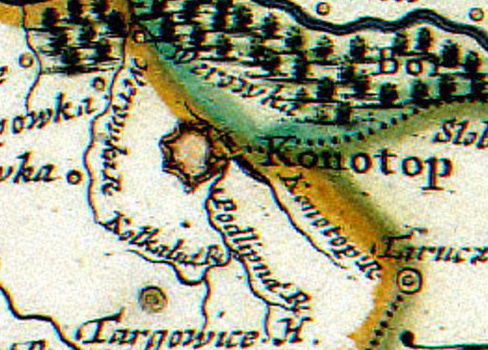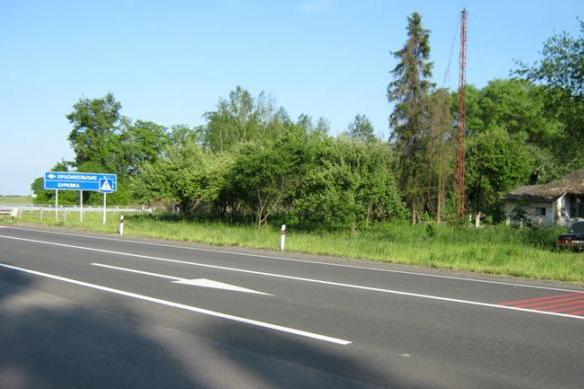|
Chernigov Governorate
Chernigov Governorate was an administrative-territorial unit (''guberniya'') of the Russian Empire. It was officially created in 1802 from the disbanded Little Russia Governorate (1796-1802), Little Russia Governorate and had its capital in Chernihiv, Chernigov. Its borders encompassed the modern Chernihiv Oblast, but also included a large section of Sumy Oblast and smaller sections of the Kyiv Oblast of Ukraine, in addition to a large part of Bryansk Oblast of Russia. From 1918 to 1925, it was referred to as Chernihiv Governorate as part of Ukraine after the Russian Revolution, Ukrainian successor states of the Russian Empire during and after the Russian Civil War, civil war, namely of the Ukrainian People's Republic, the Ukrainian State and the Ukrainian Soviet Socialist Republic, Ukrainian SSR. Administrative division When part of the Russian Empire, the governorate consisted of 15 uyezds (their administrative centres in brackets): * Borznyansky Uyezd (Borzna) * Glukhovsky ... [...More Info...] [...Related Items...] OR: [Wikipedia] [Google] [Baidu] |
Russian Language
Russian is an East Slavic languages, East Slavic language belonging to the Balto-Slavic languages, Balto-Slavic branch of the Indo-European languages, Indo-European language family. It is one of the four extant East Slavic languages, and is the native language of the Russians. It was the ''de facto'' and ''de jure'' De facto#National languages, official language of the former Soviet Union.1977 Soviet Constitution, Constitution and Fundamental Law of the Union of Soviet Socialist Republics, 1977: Section II, Chapter 6, Article 36 Russian has remained an official language of the Russia, Russian Federation, Belarus, Kazakhstan, Kyrgyzstan, and Tajikistan, and is still commonly used as a lingua franca in Ukraine, Moldova, the Caucasus, Central Asia, and to a lesser extent in the Baltic states and Russian language in Israel, Israel. Russian has over 253 million total speakers worldwide. It is the List of languages by number of speakers in Europe, most spoken native language in Eur ... [...More Info...] [...Related Items...] OR: [Wikipedia] [Google] [Baidu] |
Ukrainian People's Republic
The Ukrainian People's Republic (UPR) was a short-lived state in Eastern Europe. Prior to its proclamation, the Central Council of Ukraine was elected in March 1917 Ukraine after the Russian Revolution, as a result of the February Revolution, and in June, it First Universal of the Ukrainian Central Council, declared Ukrainian autonomy within Russia. Its autonomy was later recognized by the Russian Provisional Government. Following the October Revolution, the Central Council of Ukraine denounced the Bolsheviks, Bolshevik seizure of power and Third Universal of the Ukrainian Central Council, proclaimed the Ukrainian People's Republic with a territory including the area of approximately eight Russian imperial governorates (Kiev Governorate, Kiev, Volhynia Governorate, Volhynia, Kharkov Governorate, Kharkov, Kherson Governorate, Kherson, Yekaterinoslav Governorate, Yekaterinoslav, Poltava Governorate, Poltava, Chernigov Governorate, Chernigov and Podolia Governorate, Podolia). It F ... [...More Info...] [...Related Items...] OR: [Wikipedia] [Google] [Baidu] |
Konotop
Konotop ( ) is a city in Sumy Oblast, northeastern Ukraine. Konotop serves as the administrative center of Konotop Raion within the oblast. Konotop is located about from Sumy, the administrative center of the oblast. It is host to Konotop Air Base. The population is Name The word ''konotop'' denotes a place where horses drowned, that is, any swampy, impassable place. The word itself comes from "horses stomp", which was transformed into a noun with the help of the word-forming method of baseline. Konotop is a common Slavic toponym; settlements with this name exist not only in Ukraine, but also in Poland, Belarus and Russia. In several dialects of Ukrainian, the ''konotop'' () also refers to the herbaceous plant, common knotweed. Some historians believe that Konotop as a settlement existed even before the Mongol-Tatar invasion. According to legend, during the passage of the Tatar cavalry in the area, many horses and riders died in impassable swamps, leading to the area bein ... [...More Info...] [...Related Items...] OR: [Wikipedia] [Google] [Baidu] |
Konotopsky Uyezd
Konotopsky Uyezd (, ) was one of the subdivisions of the Chernigov Governorate of the Russian Empire. It was situated in the southeastern part of the governorate. Its administrative centre was Konotop. Demographics At the time of the Russian Empire Census of 1897, Konotopsky Uyezd had a population of 156,535. Of these, 90.9% spoke Ukrainian, 4.9% Yiddish, 3.4% Russian, 0.3% Belarusian, 0.3% Polish, 0.1% German and 0.1% Romani Romani may refer to: Ethnic groups * Romani people, or Roma, an ethnic group of Indo-Aryan origin ** Romani language, an Indo-Aryan macrolanguage of the Romani communities ** Romanichal, Romani subgroup in the United Kingdom * Romanians (Romanian ... as their native language. Демоскоп Weekly - Приложение. Справочник статистических показателей References |
Kozelets
Kozelets (, ) is a rural settlement in Chernihiv Raion, Chernihiv Oblast, northern Ukraine. It hosts the administration of Kozelets settlement hromada, one of the hromadas of Ukraine. Kozelets is located on the Oster River, a tributary of the Dnieper. Population: The town was first mentioned in written documents in 1098, but its status as an urban-type settlement (one level below that of a city) was granted in 1924. Notable attractions in the city includes the Cathedral of the Nativity of the Blessed Virgin designed in the Ukrainian Baroque style by architects Ivan Hryhorovych-Barskyi and Andrei Kvasov. Kozelets also houses several local food industries, and a veterinary technicum. History Kozelets was first mentioned in 1098 as a fortified town in the East Slavic state of Kievan Rus'. During times of the Polish–Lithuanian Commonwealth, Kozelets was known by the name ''Kozlohrad'' (). In the beginning of the seventeenth century, Kozelets was an important regional trad ... [...More Info...] [...Related Items...] OR: [Wikipedia] [Google] [Baidu] |
Kozeletsky Uyezd
Kozeletsky Uyezd (; ) was one of the subdivisions of the Chernigov Governorate of the Russian Empire. It was situated in the southwestern part of the governorate. Its administrative centre was Kozelets. Demographics At the time of the Russian Empire Census of 1897, Kozeletsky Uyezd had a population of 135,129. Of these, 95.2% spoke Ukrainian, 3.5% Yiddish, 1.0% Russian and 0.1% Polish Polish may refer to: * Anything from or related to Poland, a country in Europe * Polish language * Polish people, people from Poland or of Polish descent * Polish chicken * Polish brothers (Mark Polish and Michael Polish, born 1970), American twin ... as their native language. Демоскоп Weekly - Приложение. Справочник статистических показателей References [...More Info...] [...Related Items...] OR: [Wikipedia] [Google] [Baidu] |
Horodnia
Horodnia (, ) is a small city in Chernihiv Raion, Chernihiv Oblast, Ukraine. It has had city status since 1957. Horodnia hosts the administration of Horodnia urban hromada, one of the hromadas of Ukraine. Population: 11,240 (2023 estimate), Geography Horodnia is situated on both banks of the . History Horodnia was first mentioned in historical literature at the beginning of the 17th century. There are different ideas about the origin of its name. A source of local pride comes from three cannons presented by Peter I for the heroism of the people of Horodnia during the Swedish invasion in 1709. Until 18 July 2020, Horodnia was the administrative center of Horodnia Raion. The raion was abolished in July 2020 as part of the administrative reform of Ukraine, which reduced the number of raions of Chernihiv Oblast to five. The area of Horodnia Raion was merged into Chernihiv Raion. Horodnia was occupied by Russian forces during the ongoing Russo-Ukrainian war. Russian forces ... [...More Info...] [...Related Items...] OR: [Wikipedia] [Google] [Baidu] |
Gorodnyansky Uyezd
Gorodnyansky Uyezd (; ) was one of the subdivisions of the Chernigov Governorate of the Russian Empire. It was situated in the western part of the governorate. Its administrative centre was Gorodnya (Horodnia). Demographics At the time of the Russian Empire Census of 1897, Gorodnyansky Uyezd had a population of 162,123. Of these, 86.8% spoke Ukrainian, 7.8% Russian, 4.6% Yiddish, 0.3% Polish, 0.3% Belarusian and 0.1% German German(s) may refer to: * Germany, the country of the Germans and German things **Germania (Roman era) * Germans, citizens of Germany, people of German ancestry, or native speakers of the German language ** For citizenship in Germany, see also Ge ... as their native language. Демоскоп Weekly - Приложение. Справочник статистических показателей References ...
|
Hlukhiv
Hlukhiv (, ; ) is a small historic List of cities in Ukraine, city on the Esman River. It belongs to Shostka Raion of Sumy Oblast of Ukraine. Population: It is known for being a capital of the Cossack Hetmanate after the deposition of Ivan Mazepa in 1708–1764. History Hlukhiv was first noticed by chroniclers as a Severian town in 1152. Around 1247 it became the seat of a branch of the princely house of Chernihiv following the Mongol invasion of Rus. Between 1320 and 1503 it was part of the Grand Duchy of Lithuania before being conquered by the Grand Duchy of Moscow. In 1618 it became part of the Polish–Lithuanian Commonwealth (in the Czernihów Voivodeship of the Crown of Poland) and was granted Magdeburg rights, Magdeburg Rights in 1644 by Władysław IV Vasa. In 1648–1764 it was part of the Cossack Hetmanate within the Nizhyn Regiment (province). In 1654 the Cossack Hetmanate came under military protectorate of the Tsardom of Muscovy in accordance with the Treaty of ... [...More Info...] [...Related Items...] OR: [Wikipedia] [Google] [Baidu] |
Glukhovsky Uezd
Glukhovsky Uyezd (; ) was one of the subdivisions of the Chernigov Governorate of the Russian Empire. It was situated in the eastern part of the governorate. Its administrative centre was Hlukhiv (Russian Glukhov). Demographics At the time of the Russian Empire Census of 1897, Glukhovsky Uyezd had a population of 142,661. Of these, 91.6% spoke Ukrainian, 4.2% Russian, 3.9% Yiddish, 0.1% Polish, 0.1% Belarusian and 0.1% Romani Romani may refer to: Ethnic groups * Romani people, or Roma, an ethnic group of Indo-Aryan origin ** Romani language, an Indo-Aryan macrolanguage of the Romani communities ** Romanichal, Romani subgroup in the United Kingdom * Romanians (Romanian ... as their native language. Демоскоп Weekly - Приложение. Справочник статистических показателей References |
Borzna
Borzna (, ), also referred to as Borsna, is a city in Nizhyn Raion, Chernihiv Oblast, northern Ukraine. It hosts the administration of Borzna urban hromada, one of the hromadas of Ukraine. Population: Geography Borzna is located on the Desna (river), Desna, next to an international highway connecting Kyiv and Moscow (International E-road network, E101). Chernihiv is about away. Borzna has no Rail transport, railway (the nearest railway stations being Doch () with north–south routes and Plysky () with west–east routes. The city derives its name from the river it lies on, a tributary of the Desna River, Desna. Climate Borzna has a continental climate, humid continental climate (Köppen climate classification, Koppen ''Dfb''). The warmest months are June, July, and August, with mean temperatures of . The coldest are December, January, and February, with mean temperatures of . The highest ever temperature recorded in the town was in July 2010. The coldest temperature ev ... [...More Info...] [...Related Items...] OR: [Wikipedia] [Google] [Baidu] |
Borznyansky Uyezd
Borznyansky Uyezd (; ) was one of the subdivisions of the Chernigov Governorate of the Russian Empire. It was situated in the southern part of the governorate. Its administrative centre was Borzna. Demographics At the time of the Russian Empire Census of 1897, Borznyansky Uyezd had a population of 146,595. Of these, 93.8% spoke Ukrainian, 3.0% German, 2.5% Yiddish, 0.6% Russian, 0.1% Polish and 0.1% Belarusian Belarusian may refer to: * Something of, or related to Belarus * Belarusians, people from Belarus, or of Belarusian descent * A citizen of Belarus, see Demographics of Belarus * Belarusian language * Belarusian culture * Belarusian cuisine * Byelor ... as their native language. Демоскоп Weekly - Приложение. Справочник статистических показателей References {{Reflis ...[...More Info...] [...Related Items...] OR: [Wikipedia] [Google] [Baidu] |



